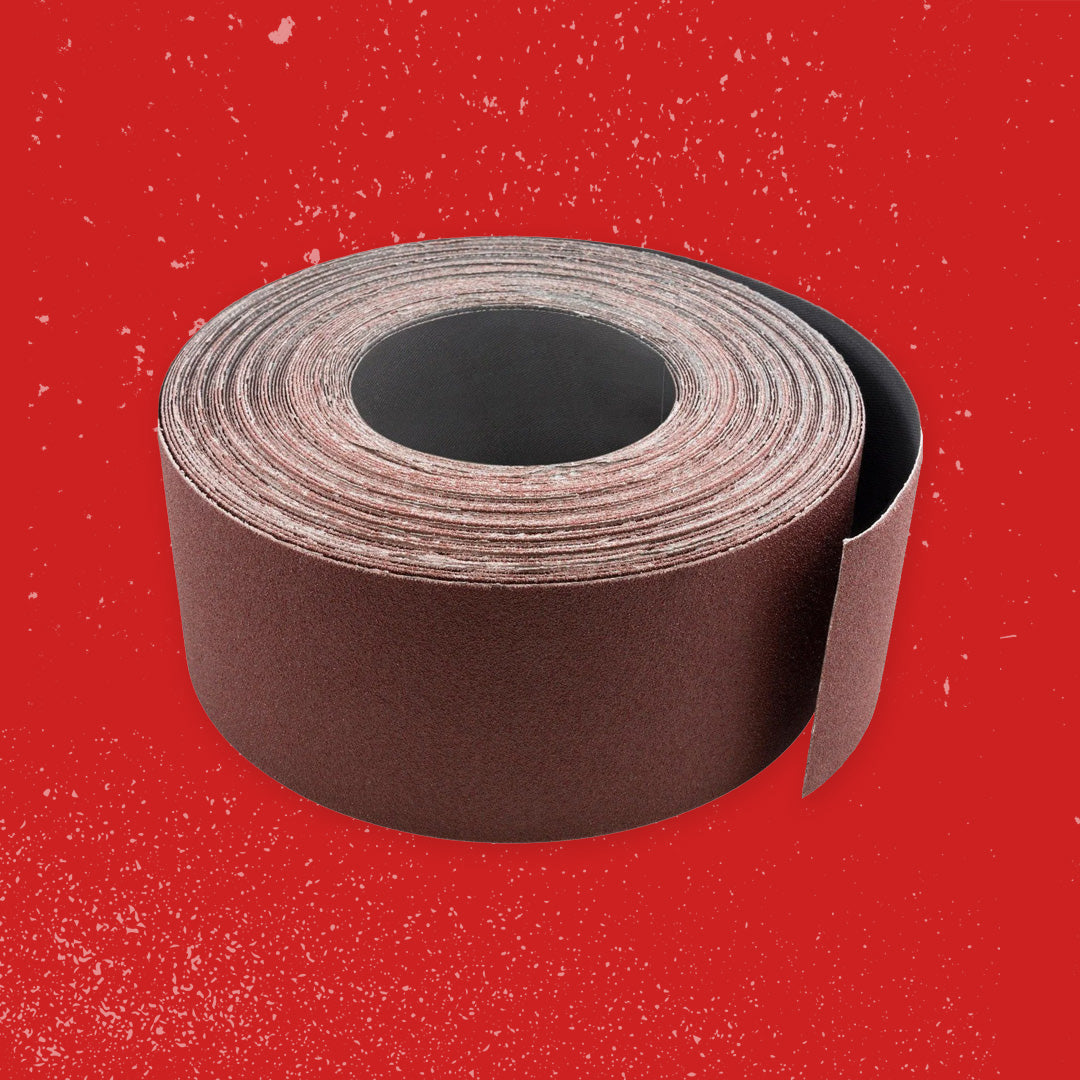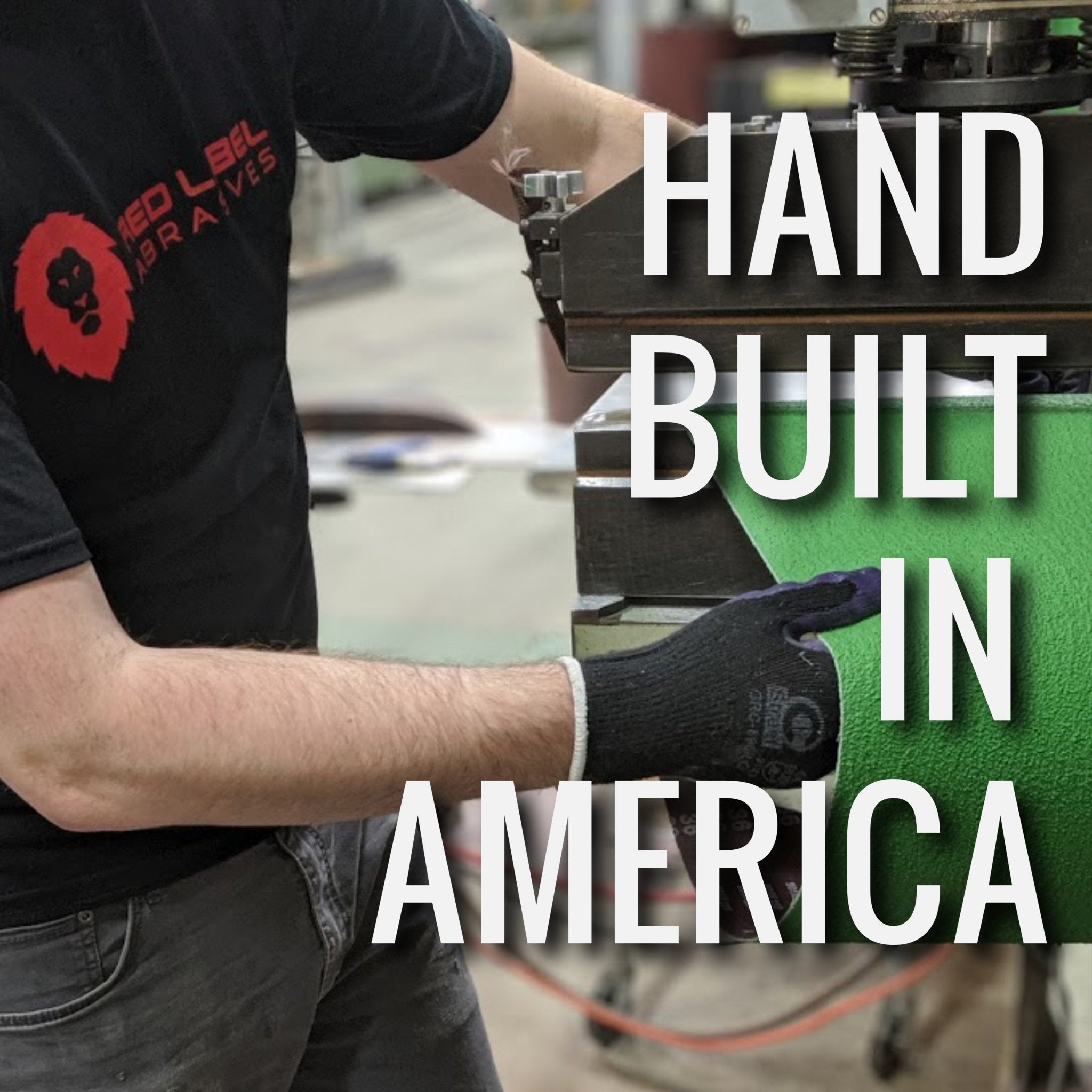Your Cart is Empty
OFFICE CLOSED 11/28 | Free Shipping over $150 (Excludes Oversized Products)
OFFICE CLOSED 11/28 | Free Shipping over $150 (Excludes Oversized Products)
Sanding Belts
Sanding Discs

What You Need To Know About Cutting Knife Blanks With a Waterjet
by David Kranker 5 min read

Pre-made knife blade blanks are ideal for novice and professional knife makers to complete their projects faster. Forged, hardened, and preshaped in advance, all that’s left to do is shape the blade to perfection and apply a handle.
Although CNC-guided laser laser and plasma applications have long been used to cut multiple planks out of a single sheet of metal, many knife makers claim that water jet technology yields a superior product with a sharper edge. It also does a precise job of cutting out scales, handles, lock faces, and more.
In this blog, the team atRed Label Abrasives goes over how you can cut knife blades with a water jet, as well as, the pros and cons of this evolving and sustainable technology.
What is a Waterjet Cutter?
Guided by CNC programming, a waterjet cutter is a machine that uses a high-pressure stream of water to create a narrow line in a sheet of material. For denser materials, the operator increases the waterjet’s cutting power by adding a granular abrasive at the nozze, so that it’s easy to switch between water and abrasive cutting.
Waterjet Cutting - the Process
Waterjet cutting is one of the most precise methods of making detailed and accurate cuts in your materials. After the machine has received information about the shape and quantity of the knife blades being cut, it goes straight to work.
Using a specially configured mixing chamber and tube, water jet machines carefully mix the abrasive grains with high-pressure waters to develop a sharp and rapid cut. It should be noted that waterjet nozzles are also designed without this mixing chamber and tube, so they fire a high-pressure stream of water, rather than an abrasive solution, to cut softer materials.
What Are the Advantages of Waterjet Cutting?
Like laser cutting, waterjet cutting is an extremely precise manufacturing process. Its flexibility and versatility are also unparalleled. In comparison with other cutting technologies, such as laser and saw cutting, waterjet cutting offers a range of advantages, many of which are highlighted below.
Superior Accuracy
Cutting accuracy of 0.1 to 0.2mm makes waterjets an ideal tool for internal cutouts. You can easily manufacture knife blade blanks of different sizes and shapes, giving you free rein to indulge in some metal working creativity.
Cuts Most Materials
A waterjet cutter can slice through almost any material that traditional cutting methods can, as well as a few others. You can cut products like aluminum, multi-layer materials, composites and hardened steels up to 25mm thick without any restrictions. Noted exceptions are tempered glass, which is too fragile, and diamonds (too hard!), but since neither of these materials play a role in knife making, this is a nonissue.
Does Not Produce Heat
Before waterjet cutting, manufacturers had to deal with heat distortion and hardened edges. High heat was generated during cutting processes, creating significant issues for workshops, handling materials with different melting points. This is where waterjets make a big difference. Since waterjet cutters use a cold cutting process, it won’t overheat the vicinity of the cutting area. In other words, your metal won’t be damaged or changed by heat stress.
A Sustainable Technology
Because they only use water to cut knife blade blanks, waterjet machines don’t create hazardous waste. They also make it easier to recycle scrap metal, since any leftover material is not heat-damaged.
Superior Edge Quality
Combining water speed, pressure, nozzle size, and abrasive flow rate creates superior edge quality. In fact, many designers and manufacturers prefer this method of cutting for its smooth, burr-free edges.
Greater Efficiency
Due to the fact that waterjet cutting requires little secondary finishing or edge treatment after cutting, your workshop efficiency will improve. You can get started on your next project sooner while those using alternative cutting methods will have to spend extra time refining their edges.
Lower Operating Costs
Since it is a cold cutting process, waterjet cutting is becoming one of the most cost-effective solutions on the market. With hot cutting techniques, parts and fittings may experience heat zones, resulting in warping and inaccuracy. Waterjets overcome this problem quite easily with their cold cutting process, so you will rarely throw away and waste material.
No Tool Changes are Required
Waterjet cutting increases operating efficiency because it allows for cutting different materials without having to change any tools. You don’t have to change nozzle heads when switching materials: all that’s needed is to adjust your feed rate to the right speed for that material’s type and thickness. By avoiding tool changes for each new cut, workshops often improve their profitability.
What Are the Disadvantages of Waterjet Cutting?
Like most technologies, waterjet cutting has its drawbacks. While they’re not huge, they should be considered, in case any of them have the potential to impact your shop’s performance.
Potential for Noise Pollution
Anyone who uses a water jet cutting machine needs to be aware of the safety risks, just as they would with any metal fabrication process. It produces surprisingly high amounts of noise, so it is essential to wear ear protection and eye protection. These are not always necessary when laser cutting, but are still recommended.
Less Accurate with Thicker Materials
Waterjet cutting places the greatest force on the area closest to the stream of water. As a result, thicker materials may sometimes cut less accurately due to the stream being further away from the point of impact.
Longer Cutting Time
Although it can process knife blade blanks at a good speed, waterjet cutting is typically slower than laser cutting. If your production line is dependent on the most rapid delivery time possible, you may have to schedule appropriately if you plan to cut everything with a waterjet.
Waterjet Cutting Services For Knife Makers
If you’re interested in waterjet cut knife blanks, it’ll likely be more cost-effective to use a cutting service instead of investing in waterjet cutting equipment. Waterjet cutting systems are very expensive. Even a small system can cost upwards of $60,000. Below are a few waterjet cutting services for knife blanks to consider.
The Next Step is a Premium Abrasive
Once your knife blade blanks are ready, you still have to do all the beveling, grinding, and sharpening, but you cut down a lot of time by eliminating the need to cut the blanks and remove stock by hand. All that’s necessary to turn a blank into a beautiful blade is applying an abrasive with the right grit and material for each stage of the process.
Red Label Abrasives manufactures and sells specialtysanding belts as well as completeknife making kits that apply a fine finish to your knife blanks. Our products have an aggressive cut, a long working life, and the quality you need to get excellent results every time. For more information about our products or to place an order, please call 844-824-1956 orfill out our contact form. ABOUT THE AUTHOR
David Kranker is a writer and creative maker who has been covering the abrasive and knife-making industries on the Red Label Abrasives Blog since 2020. David spends his time continually researching sanding and bladesmithing to provide readers with the latest and greatest information. In his free time, David utilizes abrasives for many different home and auto projects at his home in Delton, MI.
Belt Packs Made For Knife Makers

2 X 72 Inch Knife Makers Sanding Belts Assortment

2 X 60 Inch Knife Makers Sanding Belts Assortment

2 X 48 Inch Knife Makers Sanding Belts Assortment

2 X 36 Inch Knife Makers Sanding Belt Assortment

2 X 42 Inch Knife Makers Sanding Belts Assortment

1 X 30 Inch Knife Makers Sanding Belts Assortment

1 x 42 Inch Knife Makers Sanding Belt Assortment
Shop By Product Category





Why Choose Red Label?







